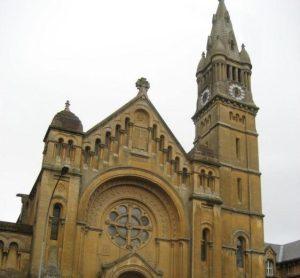Les temples peuvent se classer en trois groupes de styles :
Le style néoclassique
Après le premier temple reconstruit (Orthez en 1791) qui est très simple, la quasi-totalité des 80 temples construits dans la première moitié du XIXe siècle s’inspire du style néoclassique, reconnaissable à son goût des colonnades, des églises de la fin du XVIIIe siècle, dont le Panthéon à Paris est le modèle ; ceci s’explique par deux raisons : la première est qu’Antoine de Quincy, secrétaire perpétuel de l’Académie des beaux-arts, impose ce style pour toutes les commandes officielles et donc pour les subventions qui y sont attachées ; la seconde est que les protestants, après un siècle d’interdiction, ne sont pas fâchés d’afficher leur nouveau statut, par la ressemblance avec les bâtiments officiels. Dans le Midi de la France qui bénéficie surtout de ces constructions, on peut citer Marseille (1823), Saumur (1843), Bordeaux (temple des Chartrons, 1835) et, dans le Gard, Anduze (1823), Quissac (1832) et Saint-Hippolyte-du-Fort (1822).
Le style néo-médiéval
La mode change dans la seconde moitié du XIXe siècle, les protestants désirant désormais se fondre dans la masse : ils suivent donc la mode moyenâgeuse qui suit la redécouverte des édifices longtemps méprisés de style roman ou gothique ; si les catholiques marquent leur préférence pour le néogothique, les protestants préfèrent le néo-roman ou le néo-byzantin, tout en se limitant le plus souvent à la façade : Paris (Luxembourg, 1857), Lyon (les Terreaux, 1852), Sancerre (1894), Montpellier (1870) ou Saint-Maixent-l’École (vers 1876) ; L’Étoile à Paris (1874) en revanche est un cas d’architecture néo-gothique, que l’on trouve surtout dans les territoires annexés par l’Allemagne après la guerre de 1870 : Metz (temple neuf, 1901) ou Strasbourg (église Saint-Paul, 1892).
Des styles d’une grande diversité au XXe siècle
Le XXe siècle se caractérise par le ralentissement des constructions et l’apparition des centres communautaires, où presbytères et salles de réunion sont accolés au temple. Parmi les constructions ayant un intérêt architectural, on peut citer : Port-Grimaud (1873) avec les vitraux de Vasarely, le centre œcuménique de Jacou (Hérault, début des années 1990), Massy (1963) et Rueil (architecte : Pierre-Édouard Verret, 1968), Ermont-Taverny (architecte : Marc Rolinet, 2007) et la chapelle des diaconesses à Versailles (Rolinet, 2007).
À noter, à partir des années 1970, l’apparition d’églises évangéliques, qui se signalent par la grande simplicité de leur architecture : église protestante évangélique de Fresnes (1972) ; Villard-de-Lans (début des années 2000) ; église protestante évangélique de Nice (1993) ; Aix-en-Provence (1990).


